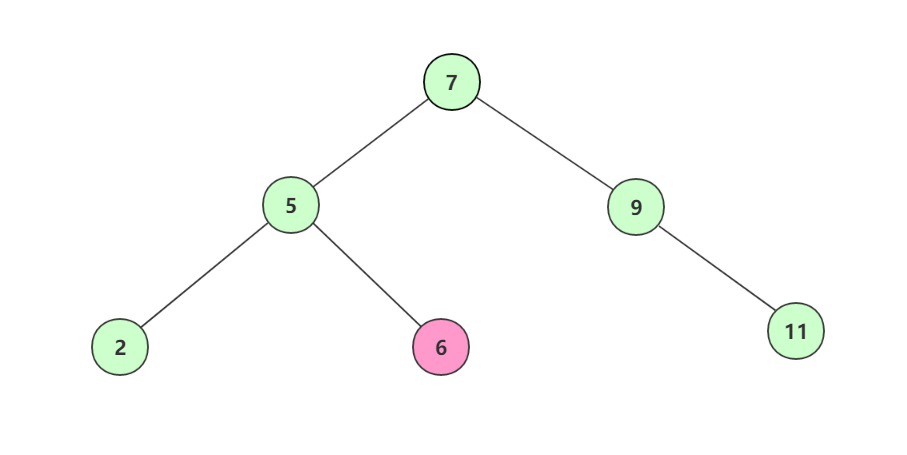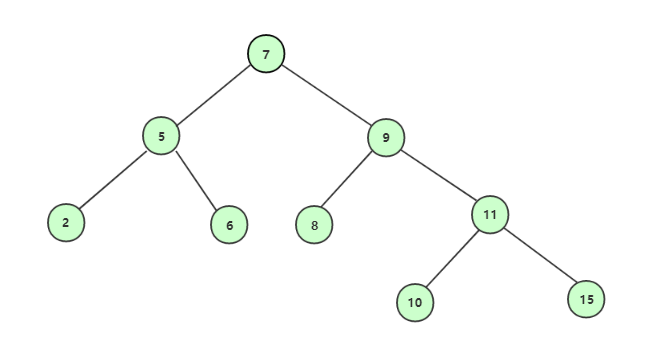
二叉查找树是将一组无序的数据构建成一颗有序数据的树,其设计思想与二分法类似。很好的提高了海量数据查找效率,使得由从头遍历到尾的方式转为二分查找的方式,时间复杂度从O(n)降低为O(log(n))。
概念
- 结点:树上的每个元素。
- 根结点:没有父结点的结点。
- 父结点:结点的上一级结点。
- 子结点:结点的下一级结点。
- 叶子结点:没有子结点的结点。
- 兄弟结点:拥有同一父结点的相邻结点。
- 结点的度:一个结点中拥有子结点的个数。
- 树的度:树上最大结点的度。
- 结点的层次:以根结点为1,每深入一个子结点层次加1。
- 树的高度:树中最大的结点的层次。
特性
- 左子树所有的结点值均小于,等于根结点值或为空。
- 左子树所有的结点值均大于,等于根结点值或为空。
- 左、右子树也分别为二叉排序树。
- 没有键值相等的结点。
构建
构建二叉查找树,主要把握几条原则,小于当前结点的在左边,大于的在右边,相等的不予处理。但是情况下结合实际业务需求,也可在相等时放在左结点或右结点,但是必须统一规则,不能左右都存在相等的。
创建结点对象:
1 | package com.ytao.bst; |
创建树的实现:
1 | package com.ytao.bst; |
使用[7,5,9,2,11,6]测试是否满足我们创建树的要求:
1 | public static void main(String[] args) { |
测试结果满足我们要求
1 | { |
查找
假设从一百万个数字中获取值为88的数据,如果我们使用遍历的方式,最糟的情况就是排在第一百万个位置的时候,需要我们遍历一百万次才能获取到数据,这就是我们最不想遇到的情况。这时将一百万个数据构建成二叉查找树,我们就可通过树快速找到我们想要的数据。
由于设定一百万个数据比较多,这里我们举例当前拥有数据[7,5,9,2,11,6],我们要找出其中的6。
使用循环遍历所有数据的方法,我们需要6次遍历 7->5->9->2->11->6。
使用二叉查找树查找时,首先构建好的二叉查找树的结构如图:

从根结点开始查找;

获取根结点7,不等于6,且6<7,所以继续找左子结点;

获取到结点5,不等于6,且6>5,所以继续找右子节点;

最终获取到结点6,满足我们需要的条件。所遍历的数据为 7->5->6。
代码实现查找:
1 | package com.ytao.bst; |
插入
二叉查找树的插入规则,必须是要插入后的结点是作为叶子结点。现在向上面的树中插入10,根据上面所分析到的规则,为确保二叉查找树的完整性,最终的插入流程为7->9->11->10:

代码实现:
1 | package com.ytao.bst; |
删除
删除结点分为多种情况,其中主要分析的:
叶子结点
删除叶子结点,将所要删除的叶子结点直接删除便可,比如删除结点6。

单子结点的结点
被删除结点,如果只有一个子结点,那么被删除结点删除后,该结点的子结点补上其位置,比如删除结点9。

存在左右子结点的结点
为了更加清楚表达删除存在左右结点的结点,先向树中多添加3个结点8,10,15。然后删除结点9。
这里的解决方法就是,删除9后,可以用前驱结点或后继结点补上。前驱结点为左子树中最大的结点,后继结点为右子树中最小的结点。
现在以后继结点补上的方案为:

后继结点补上删除后的结点:

完成删除,后继结点补充上后:

代码实现:
1 | package com.ytao.bst; |
至此上面三中情况都予满足。
总结
上面对二叉查找树的操作都已介绍,但是正真使用中,是要结合实际业务进行相关调整来满足自己的需求,不然,一切的优化手段都是假把式。二叉查找树虽然好用,但是它也是有一定要求,在数据量不大的情况下,使用遍历的方式,更加符合我们的要求,所以它使用场景一般是在海量数据的查询,用来提查询效率。


